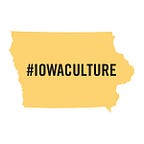A 50-year Legacy is Born
In 1967, a gallon of gas cost 33 cents, the average car cost less than $3,000, and the Iowa Arts Council officially became a state agency.
Just two years before, in the White House Rose Garden, President Lyndon Johnson signed the National Foundation on the Arts and the Humanities Act, declaring: “Art is a nation’s most precious heritage. For it is in our works of art that we reveal ourselves, and to others, the inner vision which guides us as a nation. And where there is no vision, the people perish.”
In Iowa, such a vision for supporting the arts had already begun to take root. Efforts to establish a state arts commission started gaining momentum during the administrations of both Gov. Herschel Loveless (1957–1961) and his successor, Gov. Norman Erbe (1961–1963).
The Iowa City poet and Iowa Writers’ Workshop director Paul Engle added to that momentum when he wrote to Gov. Harold Hughes in 1965 suggesting Iowa should keep up with the Joneses, so to speak:
“It may be that there should be an Iowa Council on the Arts. New York State already has one, North Carolina a very active Council, and, indeed, there is now a national organization of State Councils. … The Arts will obviously receive great attention in the future, as President Johnson has put his influence behind them. Iowa ought to share.”
Gov. Hughes agreed, and by 1966, the Iowa Arts Council existed as an ad hoc citizen committee.
But some lawmakers wanted to make it an official state agency. Rep. Dan Johnston, D-Des Moines, made a case for it in the spring of 1967. As he put it, Iowans could spend their time on cultural pursuits or “sit before a TV on a Sunday afternoon with a can of beer,” according to the Des Moines Register. The 28-year-old said he didn’t want to spend his “remaining years” in the TV-and-beer group, “although that is not too bad at times.”
In the same article, House Majority Leader Floyd Millen, R-Farmington, noted that Iowa communities had discovered that “art is one of those things that lures industry … Not everybody goes for culture, but there are more than you might expect.”
As with all proposals, there were concerns about funding, but the bill sailed through both the House (87–19) and Senate (42–2). Gov. Hughes signed it into law on July 1, 1967, and the Iowa Arts Council was born.
The Iowa Legislature appropriated $25,000 to the fledgling agency for administration and programming expenses, and the newly minted National Foundation on the Arts and the Humanities pitched in $39,383 in federal support. This federal-state partnership survives to this day, with the National Endowment for the Arts providing crucial funding to the Iowa Arts Council through an annual state partnership agreement.
During a 2015 nationwide commemoration of the federal agency’s own 50th anniversary, NEA Chairwoman Jane Chu’s visit to Iowa reinforced that partnership and its enduring relevance. “State arts agencies are some of our key partners in the field, because we’re shaping the arts in America together,” she said. “In addition to funding, we share resources and knowledge, and a common desire to see America succeed through the arts.”
For nearly 20 years, the Arts Council operated as a stand-alone agency, celebrating the work of Iowa artists, fostering arts learning in Iowa classrooms and expanding arts access in communities of every size and every region of the state.
In 1986, a reorganization of the state government’s executive branch made the Arts Council a division of a new umbrella agency, the Iowa Department of Cultural Affairs, along with the State Historical Society of Iowa. In 2013, the department also welcomed the state’s office of media production, called Produce Iowa. Together, these three divisions empower Iowans to build and sustain culturally vibrant communities by connecting Iowans to the people, places and points of pride that define our state.
Now 50 years since its inception, the enduring legacy of public support for the arts in Iowa doesn’t belong to the Arts Council alone. Countless Iowans, organizations and communities have worked alongside the Arts Council to invigorate the arts throughout the state and continue to do so today.
We’ll celebrate this shared legacy in the coming months and highlight the Arts Council’s half-century of public support for the arts in Iowa. So watch your inbox for upcoming editions of IAC News and follow the Arts Council on social media.
Because when it all comes down to it, our 50th anniversary is all about you. If you have story about your work as an artist in Iowa, your arts organization, please let us know. We’d love to share it during our ongoing celebration.
— Matthew Harris, Iowa Arts Council
